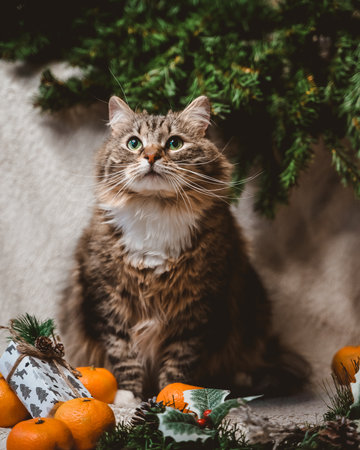Introduction to Seasonal Changes and Small Pets
In the United States, the change of seasons brings more than just shifts in weather—it can significantly impact the health and well-being of small pets like rabbits, guinea pigs, hamsters, and ferrets. As temperatures rise or drop, daylight hours fluctuate, and humidity levels vary, these environmental changes can influence everything from your pet’s appetite to their energy levels. Many pet owners may not realize that their furry companions have different dietary needs throughout the year. Understanding how seasonal changes affect small pet nutrition is crucial for maintaining their overall health and happiness. Whether it’s coping with winter’s chill or summer’s heat, being aware of these shifting nutritional requirements helps ensure your small pets stay healthy no matter the season.
2. How Temperature and Daylight Affect Pet Metabolism
Seasonal changes in temperature and daylight hours can have a significant impact on the metabolism of small pets, including rabbits, guinea pigs, hamsters, and other pocket pets. These environmental factors influence how animals process food, regulate body temperature, and maintain their energy levels throughout the year. As the days grow shorter and temperatures drop in fall and winter, small animals may experience a natural slowdown in their metabolic rates. This means they may require fewer calories to maintain their weight and avoid excessive fat storage. In contrast, when spring and summer bring longer daylight hours and warmer weather, many small pets become more active, increasing their caloric needs to support higher energy expenditure.
Additionally, some species are more sensitive to these seasonal shifts than others. For example, hamsters might enter a state called torpor—a temporary hibernation-like condition—if temperatures drop too low or if they sense a reduction in daylight. This adaptation helps them conserve energy but also means their nutritional requirements change dramatically during this period. On the other hand, animals like guinea pigs do not hibernate but will still adjust their feeding patterns based on temperature fluctuations.
| Season | Temperature | Daylight Hours | Pet Activity Level | Metabolic Rate | Dietary Needs |
|---|---|---|---|---|---|
| Winter | Low | Short | Reduced | Slower | Lower calorie intake; more fiber for warmth |
| Spring/Summer | High | Long | Increased | Faster | Higher calorie intake; hydration focus |
| Fall | Mild/Cooling | Decreasing | Transitional | Adjusting | Slightly reduced calories; prepare for winter changes |
The key takeaway is that pet owners should observe their small pets closely as seasons change. Adjusting diet according to temperature and daylight variations ensures your furry friends stay healthy and comfortable all year round. Always consult with a veterinarian for species-specific advice to keep your pet’s nutrition on track as the environment shifts.
![]()
3. Winter Nutrition: Keeping Small Pets Healthy and Warm
As temperatures drop, small pets like rabbits, guinea pigs, hamsters, and ferrets face unique nutritional challenges. Their bodies require extra energy to maintain warmth and stay active during the winter months. To support their health, pet owners should be aware of specific dietary adjustments that help keep their furry friends comfortable and thriving.
Increased Caloric Needs
Colder weather means your small pet will burn more calories just to stay warm. This is especially true for pets housed in cooler parts of your home or in outdoor enclosures. Providing a slight increase in high-quality pellets, seeds (for species that can safely eat them), or hay can help meet these higher energy demands. However, avoid overfeeding to prevent obesity—aim for a balanced increase based on your pet’s size and activity level.
Safe Sources of Extra Calories
When boosting your pet’s calorie intake, focus on safe, nutrient-rich foods. For herbivores like rabbits and guinea pigs, adding a little alfalfa hay (if appropriate for their age and health) or offering an extra serving of leafy greens can provide healthy energy. For omnivorous pets such as hamsters and gerbils, offering small amounts of unsalted nuts or whole grains—like oats or barley—can give them the extra fuel they need without upsetting their digestive systems.
Hydration and Vitamin Support
Winter air tends to be dry, so make sure water bottles don’t freeze or get clogged. Dehydration can sneak up on small pets in wintertime. Additionally, consider supplementing with vitamin C for guinea pigs, since they can’t produce it themselves and may need extra immune support when stressed by cold weather.
By making thoughtful dietary adjustments as temperatures dip, you’ll help ensure your small pets stay healthy, energetic, and cozy all winter long.
4. Summer Diets: Preventing Dehydration and Overheating
During the hot summer months, small pets like rabbits, guinea pigs, hamsters, and ferrets are especially vulnerable to dehydration and heat stress. Their bodies are much more sensitive to temperature changes than larger animals or humans. As a pet owner in the U.S., its crucial to adapt your pet’s diet and hydration strategies to help them stay cool and healthy when temperatures soar.
Tips for Keeping Small Pets Cool and Hydrated
- Offer Fresh Water Frequently: Make sure your pet always has access to clean, cool water. Replace water at least twice a day, and consider using ceramic or stainless steel bowls that keep water cooler longer.
- Incorporate High-Moisture Foods: Leafy greens like romaine lettuce, cucumber slices, and bell peppers have high water content and can help keep your pet hydrated.
- Avoid Sugary Fruits: While some fruit is fine in moderation, too much sugar—especially in the heat—can upset their digestion and contribute to dehydration.
- Feed Smaller Portions More Often: Offering fresh food in smaller amounts throughout the day helps prevent spoilage during hot weather, which can otherwise lead to gastrointestinal issues.
- Provide Shade and Cool Areas: Even with proper diet, pets need an environment that stays cool. Keep cages away from direct sunlight and provide frozen water bottles wrapped in towels as makeshift chillers.
Foods to Avoid During Hot Weather
| Food Item | Reason to Avoid |
|---|---|
| Dried Fruits & Seeds | High in sugar; may increase risk of dehydration and digestive upsets in heat |
| Bread & Crackers | Can cause bloating; not hydrating or suitable for most small pets |
| Lettuce Varieties Like Iceberg | Poor nutritional value; may cause diarrhea if fed in large amounts |
| Cabbage & Broccoli (in excess) | Can cause gas and discomfort, especially when pets are already stressed by heat |
| Processed Treats (store-bought snacks) | Often high in fat and sugar, making them harder to digest in summer conditions |
Key Takeaways for Summer Pet Nutrition
- Focus on hydration first—water is more important than ever during summer.
- Select foods that are both nutritious and have high moisture content.
- Avoid foods that can spoil quickly or add unnecessary sugar and fat to your pet’s diet.
- If you notice signs of overheating—panting, drooling, lethargy—contact a vet immediately.
Your proactive approach to seasonal nutrition will keep your small pets happy, cool, and healthy all summer long!
5. Seasonal Produce and Safe Treats
When it comes to small pet nutrition, incorporating seasonal produce and safe treats is a great way to keep your furry friends healthy and happy. As the seasons change, so does the variety of fresh fruits and vegetables available in local markets, offering opportunities to diversify your pet’s diet with nutrient-rich options that are at their peak. However, not all produce is suitable for every species, so it’s important to choose wisely and prioritize safety.
Spring and Summer Choices
During spring and summer, you’ll find an abundance of leafy greens like romaine lettuce, dandelion greens, and herbs such as parsley and cilantro—favorites among rabbits, guinea pigs, and hamsters. Berries like strawberries and blueberries become more affordable and make occasional sweet treats loaded with antioxidants. Always wash produce thoroughly to remove pesticides and avoid feeding items high in sugar or oxalates in excess.
Autumn Harvest Options
Fall brings crisp apples (seedless), pumpkin, squash, and carrots. These can be offered sparingly due to their sugar content but provide valuable vitamins and fiber. Remember to avoid apple seeds and pits from stone fruits, as they can be toxic to many small pets. Pumpkins are particularly beneficial for digestive health when given in moderation.
Winter Produce Picks
In winter, options may seem limited, but staples like kale, collard greens, Brussels sprouts, and root vegetables are generally available. Rotate these veggies into your pet’s diet to prevent boredom and ensure a steady intake of nutrients even during colder months. Frozen fruits or veggies can be used if fresh choices are scarce—just ensure they are free from added sugars or preservatives.
Safe Treat Guidelines
Treats should never exceed 10% of your small pet’s daily diet. Opt for store-bought options made specifically for your pet’s species or create homemade treats using safe ingredients like unsweetened oats or timothy hay cubes. Avoid chocolate, onions, garlic, grapes, raisins, avocado, and anything processed or seasoned. Always introduce new foods gradually to watch for any adverse reactions.
Consulting Your Veterinarian
If you’re unsure which seasonal produce or treats are appropriate for your pet’s needs or species-specific sensitivities, consult with an experienced exotic animal veterinarian. They can help tailor a rotating menu that supports your small pet’s nutritional health throughout the year while keeping things interesting and safe.
6. Monitoring and Adjusting Your Pet’s Diet Through the Year
Seasonal changes bring shifts in your small pet’s nutritional needs, so it’s important to keep a close eye on their health and body condition as the weather changes. Regularly observe your pet for signs such as weight gain or loss, changes in fur quality, activity levels, and appetite. These indicators can help you identify whether your pet is thriving or if their diet needs a tweak.
Track Body Condition and Weight
Make it a habit to gently feel your pet’s body for fat cover and muscle tone every few weeks. For example, during colder months, some pets may naturally gain a little extra weight, but excessive weight gain can lead to health problems. Likewise, in summer, be alert for unexpected weight loss due to increased activity or heat stress. Maintaining a simple log of your observations helps you notice subtle trends before they become major issues.
Adjust Feeding Portions Mindfully
If you see changes in your pet’s body condition, consider adjusting portion sizes or food types accordingly. During winter, slightly increasing food for pets that are more active or outdoors can help them stay warm. In contrast, summer might call for lighter meals if your pet is less active due to heat. Always introduce dietary adjustments gradually over several days to avoid digestive upsets.
Know When to Consult Your Veterinarian
If you notice persistent changes—such as ongoing weight loss, dull coat, lethargy, or digestive issues—it’s time to consult your veterinarian. They can recommend specific dietary changes tailored to seasonal demands and your pet’s unique health profile. Annual wellness checks are also a great opportunity to review your pet’s nutrition plan with a professional.
By actively monitoring and thoughtfully adjusting your small pet’s diet throughout the year, you’ll support their well-being through every season. Staying proactive ensures that your furry friend enjoys optimal health no matter what the weather brings.


